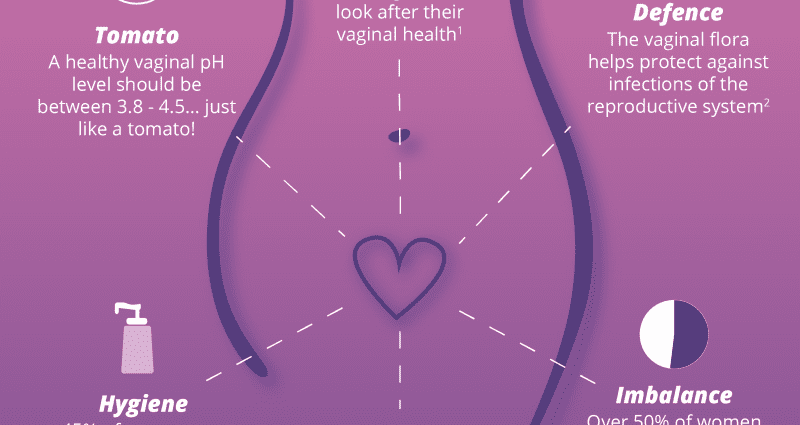Contents
Vaginal acidity, vaginal pH, lactobacilli: a delicate balance
The vaginal flora, or vaginal microbiota, brings together all of the microorganisms, in this case bacteria, which evolve within the vaginal cavity. Called lactobacilli, or Döderlein flora, these “good” bacteria are there to prevent “bad” pathogens from proliferating and do not cause yeast infection, itching, vaginosis and other intimate discomforts. The vaginal flora thus constitutes a delicate balance of different bacteria, which make it possible to maintain the pH of the vagina between 3,8 and 4,2, which corresponds to the natural acidity of the vagina.
Factors that can lead to an imbalance of the intimate flora
Different factors, internal or external, can cause an imbalance in the vaginal microbiota. This is particularly the case:
- wearing synthetic and / or too tight clothing;
- taking medication (antibiotic or hormonal treatments in particular);
- natural hormonal factors (pregnancy, menopause, physiological variations in estrogen levels during the menstrual cycle);
- tobacco consumption;
- stress or fatigue;
- inadequate personal hygiene because it is too frequent or too aggressive (with “stripping” shower gels with an unsuitable pH, or via vaginal douches).
- poor toilet hygiene (wipe from front to back to prevent the migration of germs from the anus to the vaginal area and urethra).
Imbalance of the vaginal flora: what about pregnancy and sexual intercourse?
It is not the sexual intercourse in itself which harms the intimate flora of the woman. These are more friction, which can cause faecal bacteria to migrate from the anus to the vaginaor to the urethra, and thus cause mycosis or cystitis. This is also why women are strongly advised to urinate after heterosexual intercourse with penetration.
As for semen, it temporarily increases the pH of the vagina. But this imbalance is generally transient, all the more so if the vaginal flora is rich in lactobacilli and therefore well balanced.
Pregnancy is a period of fragility for the vaginal flora, due to significant hormonal upheavals. Vaginal infections are therefore more frequent since the vaginal flora is more vulnerable to pathogenic viruses and bacteria. Pregnant women must be particularly vigilant to keep a balanced vaginal flora, especially since a vaginal infection can cause risks to the health of the fetus.
Signs of an unbalanced vaginal flora
The signs and symptoms of an unbalanced flora are irritation, itching, cystitis or repeated urinary tract infections, repeated episodes of vaginal yeast infection, unpleasant odors, burning sensations, unpleasant or even painful intercourse. Feeling one or more of these symptoms should lead to questioning your vaginal flora, or even to consult a general practitioner, a gynecologist or a midwife to discuss this intimate subject. Because these manifestations can be the sign of a well-established imbalance, which can cause various infections. Better to take the lead before you suffer from bacterial vaginosis or even a vaginitis, an inflammation of the vagina linked to an infection.
Note that it is possible to assess the state of the vaginal flora using a sample taken and then analyzed in the laboratory. The test will provide a score de Nugent, whose scale goes from 0 to 10. A result between 0 and 3 means that the vaginal flora is normal and balanced, while a score between 4 and 6 is the sign of an imbalance.
How to treat and restore your vaginal flora in case of imbalance?
The use of probiotics
To limit any risk of imbalance or attempt to rebalance a vaginal flora whose composition is imperfect, one can opt for probiotics by the vaginal route, which are none other than lactobacilli, naturally present in the vagina.
If they are more than recommended after a yeast infection or bacterial vaginosis, after antibiotic treatment (oral or intravaginal) or even after the use of tampons during menstruation, it is possible to use preventive vaginal probiotics, or as a maintenance cure of the vaginal flora. They usually come in the form of capsules, capsules or eggs to be inserted deep in the vagina, preferably at bedtime. There are also tampons impregnated with lactobacilli to use as periodic protection during menstruation.
The importance of diet for the vaginal microbiota
Although it does not act directly on the intimate flora, food plays an important role in the balance and maintenance of the microbiota, both intestinal and vaginal.
Eating yogurts, sauerkraut or miso, drinking kefir or kombucha are all means of acting indirectly on the balance of the vaginal flora, because of the richness of these foods in lactic ferments.
In general, a healthy and balanced diet, rich in fruits and vegetables, is strongly recommended for the proper functioning of the body. These foods contain prebiotics, in other words food for the good bacteria in our microbiota.










